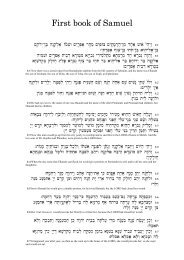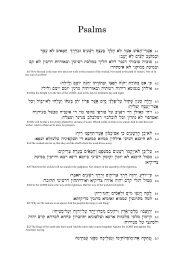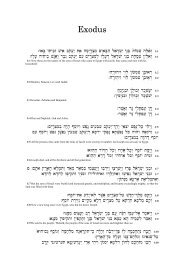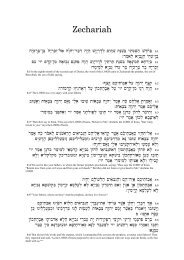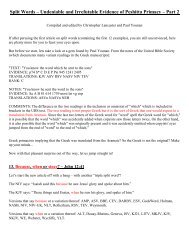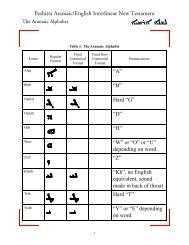ana translation
Untitled - Peshitta Aramaic/English Interlinear New Testament
Untitled - Peshitta Aramaic/English Interlinear New Testament
- No tags were found...
You also want an ePaper? Increase the reach of your titles
YUMPU automatically turns print PDFs into web optimized ePapers that Google loves.
INTRODUCTION<br />
Ixvii<br />
SECTION XIX. The Harklensian Version and the A-text.<br />
1. As regards the coincidences between the A-text and the Harklensian,<br />
and the suggestion that they are due to editorial corrections made<br />
in the former to conform it to the latter, I have remarked (pp. 98, 99,<br />
110, infr.)<br />
on the perversity of the criticism to which that suggestion<br />
belongs.<br />
I have now to point out that (as we have seen in last<br />
Section that the Arabic does not always corroborate the B-text, so<br />
likewise) the A-text is not uniformly in agreement with the Harklensian.<br />
As we there saw that A sometimes has the Arabic on its side,<br />
so we now meet the counter fact that B sometimes (though rarely) has<br />
erred in company<br />
with the Harklensian. A notable instance of this<br />
occurs 2 Pet. i.<br />
15, where the Harklensian leads, and all the B-group<br />
(but not the Arabic) with most of the intermediate follow, in adopting<br />
against the A-group the plainly erroneous reading o-TrovSao-are. So<br />
again, 2 Pet. ii. 10, the Harklensian with the B-text, not the A-text,<br />
reads ev e7ri0u/ucus for iv fTnOvfjLLa<br />
'<br />
ib., 11, omits Trapa Kvpio> ; and,<br />
2 Joh. 5, omits u>s before wroXrjv. In these cases therefore Professor<br />
Merx's theory of the A-text fails absolutely.<br />
2. Further, even in the cases where the A-group agrees (as against<br />
the B-group) with the<br />
Harklensian as regards the Greek text represented,<br />
it differs as regards the Syriac word employed. Thus, (a)<br />
2 Pet. i. 4, the Harklensian is with A against B in representing eTrayye'A-<br />
/Ltara (see Sect, xvn, head i., a, p. Ixii) ;<br />
but the Syriac equivalent used<br />
by Harklensian is llnLoLD, not (as Philoxenian, A-text) ]-iJOCL<br />
.<br />
Again, ((3) 76., Harkl. (head ii., h, p. Ixv) renders rt/xia by fyO i V)<br />
not (as Philox., A) by "\" - - (which is rather = rt/x^ra). Again, (y)<br />
3 Joh. 6, Harkl. (head iii., p. Ixv) renders Trpoirtfjuf/as by ]oVf> not<br />
(as Philox., A) by >O^D.<br />
Lastly, (8) Jud. 10, Harkl. (again head iii.,<br />
p. Ixvi) renders aAoya by ]AVi Vf) 11 ,<br />
not (as Philox., A) by ]AV**.<br />
It is obvious that if the A-readings in these places were corrections<br />
made by an editor of the Philoxenian to assimilate it to the Harklensian,<br />
the assimilation would have extended to the Syriac equivalent<br />
employed, as well as to the Greek text followed.<br />
3. Moreover, in one of the above examples, the Harklensian, in discarding<br />
the A-rendering, attests the A-reading against the B-reading,<br />
namely, 3 Joh. 6. Here,<br />
its margin, though its text renders



